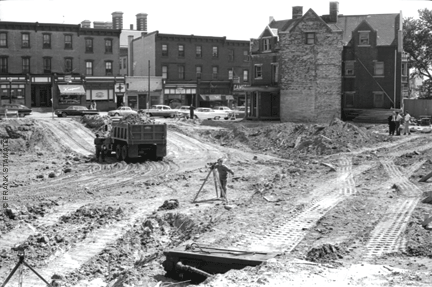
Five decades on, the University’s central library is still doing the job.
By John Prendergast | Photography by Greg Benson
Sidebar | Interesting Times at Van Pelt

Among its many other admirable qualities as a top-flight venue for research and scholarship, Van Pelt Library is an inspiration to the middle-aged. Penn’s main library building, which celebrated its 50th birthday in October, is in better shape today than when it was barely into its teens:
“Since the opening of Van Pelt in 1962 and Dietrich in 1967, the University Library has been housed for the first time in its history in spacious, air-conditioned, fire-proof buildings,” notes the 1975-76 annual report. “However, as with many new buildings, certain deficiencies in the furnishings, equipment, and arrangements became apparent and caused a serious diminution in the usefulness of these basically fine facilities. There were recurring failures of the heating and ventilation system, noisy fluorescent light fixtures, unpainted walls, hard floor coverings, insufficient lounge-type reading facilities, and poor maintenance. These various defects had earned the Library a reputation for being an uncomfortable, uninviting place in which to study, and many students and faculty members were repelled by it.” (Emphasis added.)
Ouch.
By contrast, today’s Van Pelt—featured in the accompanying photos—is coming off well over a decade of extensive upgrades and improvements, soon to be crowned by the makeover of the Rare Book and Manuscript Library’s sixth-floor home, scheduled to reopen early in the new year. These efforts have created new technology services, carved out sought-after classroom spaces, provided more comfortable study and lounge areas, even introduced a café!—all while balancing the needs of the digital future with maintaining and expanding the library’s print collections.


Not that the place is a palace. There’s not much that could be done to make the cinderblock walls on the stacks floors more cozy, for example, and on a walk around the building it’s easy enough to find scuffs on the linoleum floors and paint chipping off the metal stacks. Plus it doesn’t take long for college students to make new furniture look shabby. But overall it’s a big improvement from what many alumni (including this writer) will remember from their own student days—much less repellent.
The Charles Patterson Van Pelt Library was dedicated on October 22, 1962. It was named in memory of the slain son of an associate trustee of the University and his wife, who were donors to the library’s construction, which was, however, paid for mostly by state funds, like many University buildings of the era.
Penn’s then-President Gaylord Harnwell Hon’53, speaking at the dedication, emphasized that the new building had been a long time coming. “For 50 years the University has needed a new library,” to replace the old one “geared to the needs of a gracious but more leisurely Victorian age,” the eminent physicist declared. (That would be the 1891 Frank Furness-designed icon, now the Fisher Fine Arts Library.)
Libraries Director Kenneth Setton also subtly dissed his elders, noting that that old “terra cotta fortress” had been confidently expected to “supply the needs of the Library for a hundred years to come,” which, by Harnwell’s reckoning, was about 80 years off the mark.
Setton went on to report that Horace Howard Furness—Frank’s brother, Shakespeare scholar, and library committee chair—had deemed the old library “to possess neither the slightest flaw nor to admit of the most trivial improvement” after its opening. The new guys weren’t making that mistake: “We are delighted with [the new library],” Setton said, “but we do not regard it as perfect. We know it will not meet our needs for a hundred years.”
Maybe not, but at 50 no one’s talking about replacing it.
In his office on Van Pelt’s second floor, beyond a spacious study area, H. Carton Rogers III, vice provost and director of libraries, pages through a typewritten plan authored in 1949 by Charles Wendell David Hon’55, who held the post from 1940 to 1955 and championed the new-library cause. David was “widely recognized as an expert on library space,” says Rogers, and “very forward-looking in his thinking about future needs of scholars and the future adaptability of library buildings.
“Let me see if I can find that part … ‘Hence it is imperative that the building be planned and constructed with a practical maximum of flexibility.’”


One key result of that approach was to make the stacks in Van Pelt free-standing. In Furness and other traditional libraries, each stack supports the next one going up—meaning that they are part of the building’s structure. In Van Pelt, support pillars keep the building erect. “If you look at the way this building is designed, you can easily create a lot of open space,” Rogers says. “You can enlarge reading rooms or offices, or create more stack space, whatever.”
Harnwell and Setton’s mid-century snarkiness aside, as a piece of architecture Van Pelt has never gotten the love lavished on Furness. In Building America’s First University, their architectural and historical guide to Penn, authors George Thomas Gr’75 and David Brownlee dismiss Van Pelt—designed by Harbeson, Hough, Livingston, and Larson—in a sentence: “Insistent concrete verticals lend a measure of Athenian dignity to an otherwise lackluster design.”
But Rogers offers anecdotal evidence that the building at least fulfilled the designers’ intentions. Shortly after becoming director in 2004, he was visited by a man who introduced himself as one of the original architects. After getting a tour, “he said, ‘You know, this is really heartening, because this is exactly what we hoped,’” Rogers recalls. “‘This interior doesn’t look very much like the building that we produced in 1962, because you’ve modified almost every space in the building—but that’s exactly what we were trying to promote.’”
Van Pelt is designed to hold two million volumes, and even back in 1949, when Charles David was hatching his plan, it was possible to foresee that the University’s collections would exceed that figure. For a long time Penn has employed various off-site storage locations; currently there is a large facility in South Jersey to help manage the more than 7 million volumes Penn has today.
The tension between maximum access to materials and limited space is a perennial one, says Rogers. “To think that somehow everything that we own in a particular subject area is going to be available [in the stacks] hasn’t been true for 75 years.”
But, he adds, back in the 1970s and ’80s, it was regularly predicted that Van Pelt would reach capacity by around 1985. “So I think we’ve done a really terrific job for the last 37 years of keeping the wolves at bay, because we continue to collect tens of thousands of print materials, even though we live in a digital age.” That means a constant moving of materials to and from storage, he says. “We’ve pretty much reached a one-in, one-out kind of situation here.”
Rogers sees the past decade as an exciting one for libraries—“challenging because we are trying to balance this mix of digital and print in effective ways, which is hard,” he says. “But I think it’s been great.”
As much as possible, decisions about redesigning library spaces are “metric-based,” Rogers says. “We pay a lot of attention to use statistics. We watch trends. Again, we try to anticipate, try to keep in front of our users, if that’s possible.”
Across campus, there is a huge variation in disciplinary needs. In any future redesign of the Biomedical Library, for example, “you will see as close to a bookless library as we’ll get at Penn,” Rogers says.


At Van Pelt, which serves a wide range of communities—from Wharton to the Music Department—things get more complicated. But while the rate of decline varies, use of print collections in all fields has been on a downward trend, Rogers says, and that’s likely to continue. “So, how will that inform the way we use all the space in this building that we currently use to house print collections? It’s a real tension in research libraries today. Penn’s no different than any other research library.”
Even if they’re not there for the books, though, people will still come to the library. “Just in the way that you see communities investing in their public libraries as community spaces—not just repositories of print material, but real community spaces, where people meet—if you think about library spaces in that way, then I don’t think we’re done.”
One key development, says Rogers, “is that we are working more and more with faculty in the use of primary research materials in the classroom. There’s been a clamor for more classroom spaces in the library,” many of which have been created around the stacks, with more to come in the sixth-floor renovation.
While it’s typically Exhibit No. 1 in discussions of how the University once “turned its back” on the city, thanks to the unappealing façade on Walnut Street, the library’s placement facing College Hall went a long way toward forming the campus core—and also sent a signal about the library’s central significance at Penn. “Whoever decided to put us here did us a great turn, because we do have the opportunity to play a unifying role here at Penn. And I don’t think that’s changed,” Rogers says. Of the more than 1.5 million visits made to Penn’s libraries annually, the “lion’s share” are to Van Pelt.
“This is, in many ways, where it’s happening for the students socially, academically. And I think one of the reasons that we continue to be used as heavily as we are is that we have everything here. We have easy access to digital information, which they can get in their dorm rooms, generally. But we also have print material that supports the digital. We have a lot of technology freely available here. And we have staff expertise on hand,” which can be invaluable in guiding patrons “through that thicket of information to figure out what’s really important,” he adds.
Being fit at 50 doesn’t come easy.
Van Pelt’s ongoing makeover has depended on “the hard work of a whole lot of people raising money and doing renovation,” says Rogers, all with the goal of meeting users’ needs and making the library a welcoming place.
“We’re doing a better job of maintaining our spaces. We are more concerned about creature comforts than we’ve ever been, so you see an awful lot of soft seating here.” The library has become comparatively easygoing about certain once-taboo student behaviors, too. “People aren’t always with us on the issue of food and beverages in the library. But if we’re going to build a café in the library, it seems sort of mean-spirited to say, well, you have to sit in the café to eat and drink,” he says.
In a building that sees 5,000-6,000 people coming and going daily, “we could tell you a lot of stories about good users, bad users, things that we’ve found in various parts of the library,” says Rogers, intriguingly. (“These are places we generally don’t want to go,” he adds, disappointingly.)
“But I think it speaks to a very actively used building that continues to be vibrant and play a critical role on campus. The biggest fear is to lose your relevance, and I don’t think that has happened at all.”
SIDEBAR
Interesting Times at Van Pelt

There aren’t many people who remember the campus before Van Pelt Library was built, but one person who does is Frank Stamato. He’s also the one to thank for a series of photos documenting the building’s construction, the subject of an ongoing exhibit in the library’s first-floor Kamin Gallery.
Stamato has worked for Penn’s library system since October 1958. Fresh out of the service, he came to interview for a job in the carpentry shop, where his father worked, but wound up getting hired in the library because he knew his way around a 35-mm camera, used for microfilming.
As part of the effort to make the case for a new library building, Stamato was asked to photograph all the departmental libraries “to show what kind of shape they were in.” Then, after approval was given by the trustees, he was enlisted to document the new building’s construction. “I would go out, like once a week, to take pictures of everything,” he says, “which I did, from the day they started it.”
Sadly, Stamato’s photographs of the departmental libraries at mid-century disappeared at some point. The construction photos also seemed lost. Back when he was taking them, he would develop his film, put the prints in a dated folder, and they would then be filed. At some point they went missing. For his part, Stamato forgot about them over the years.
Then one day he overheard John Pollack, the library specialist for public programs, lamenting to Libraries Director H. Carton Rogers “about the library being 50 years old, and they don’t have anything,” he says, and he remembered the photos. When he was told they were nowhere to be found, “I said, ‘Well, I have the negatives.’” He brought them from home, where they’d been stored in an old tin; they were digitized at the library’s Schoenberg Center for Electronic Text & Image, and the rest is refound history.


Stamato was “going on 21” when he started at Penn, and turned 75 in August. His job these days is to handle internal copying needs and service the library’s photocopiers. He helped organize the union—“Local 590. Matter of fact, I’m the last survivor of the original organizers”—and doesn’t seem in any hurry to retire. “Penn has been very, very good to me,” he says.
And while he allows that “it was interesting when they were building this place,” his role in documenting the construction is not his most memorable experience related to Van Pelt. That would have to be the time in the 1970s when he saved a man’s life.


He was exiting Van Pelt from the Walnut Street side, “and a bucket came down and splattered,” he says. He looked up to see a window-washer, whose scaffolding had given way, clinging to the sixth-floor ledge “like Spiderman.” He charged up the stairs—“back then I was able to do it”—and out to the terrace, reached over and grabbed the window-washer by his belt, and hoisted him up and over the ledge.
After Stamato had gotten him to safety, the window-washer’s partner showed up. “We got on the elevator, and I said, ‘Are you OK? You want a drink of water?’ He said, ‘No, I’m OK, I’m OK.’ His friend said, ‘You know, you could have got killed.’ And the guy faints, right in the elevator,” Stamato says.
“Yeah, that was some effort. I’m glad it was the bucket, and not him.”—J.P.




